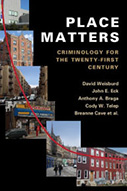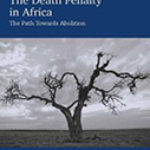Place Matters: Criminology for the Twenty-First Century

Authors: David Weisburd, John E. Eck, Anthony Braga, Cody W. Telep, Breanne Cave, et al.
Publisher: New York: Cambridge University Press, 2016. 200p.
Reviewer: Joseph Margulies | September 2016
PRIDE OF PLACE
Some of the most important research in criminology today concerns the hyper-concentration of crime at micro-units of geography. Crime is far more localized, and far more tightly concentrated, than generally thought. In Place Matters: Criminology for the Twenty-First Century, 18 leading criminologists have teamed to produce an accessible, tightly written account of this extraordinarily important insight. The book is a great contribution to the literature, and deserves to be carefully studied and widely read.
The emerging criminology of place relies on five, equally important findings:
- An inordinate fraction of all reported crime occurs at a tiny fraction of the city. Studies in Minneapolis, Boston, Seattle, Cincinnati, Tel Aviv, Sacramento, and New York, as well as several smaller cities, all reveal the same pattern: Roughly half the crime in a city takes place at only 4% of the street segments; a quarter occurs at about 1.5% of the segments.
- In every city, most places are entirely crime-free, at least as measured by calls to the police.
- These micro-places are distributed throughout the city—not quite randomly, but certainly not confined to areas of concentrated social disadvantage.
- The distribution is durable. Without intervention, the same locations stay “hot” year after year; crime does not simply wander from one spot to another.
- Finally, and perhaps most importantly, when authorities cool a hot spot by altering the conditions that make it criminogenic, crime does not merely displace to another location. On the contrary, rather than observe a displacement of crime, researchers tended to see a diffusion of benefits; areas nearby tended to improve, showing fewer signs of social disorganization.
If scholars and law enforcement follow this research through to its natural conclusion, the results can be transformative. At the theoretical level, the research can bridge opportunity and social disorganization theories, which have hitherto provided radically different explanations for crime. Opportunity theory tries to explain criminal activity by looking broadly at the varying interactions over time among offenders, victims, and places, recognizing the relevance of all three to the crime calculus. Social disorganization theorists, by contrast, posit that crime is related to structural conditions like poverty, ethnic heterogeneity, residential stability, and collective efficacy. Because they have focused on these larger structural conditions, social disorganization theorists in the past have paid relatively little attention to particular places. At the risk of some over-simplification, opportunity theorists focus on the specific criminal act, while social disorganization theorists focus on the larger environment in which the criminal act occurs.
The research into micro-places links these two perspectives. The great contribution of the research is not simply its focus on the place where crime occurs. After all, that insight came long ago with the advent of hot spot policing. Rather, the research into micro-places leads us to ask how a community can alter the characteristics of a specific address or street segment in a way that radically changes the calculus of criminal opportunity. Sometimes that disruption will be in the form of more visible policing (as with hot spot policing). But more commonly, and far more effectively, the disruption will come from long-term changes in the way owners and managers use and control the place—a change in which the community and the various levers of the state, of which the police are only one, can work as long term partners. The result is to shift primary responsibility for community wellbeing from the police to the community as a whole.
And it is precisely this shift to the community that provides the link to social disorganization theory. The Holy Grail for social disorganization theorists is an enforcement strategy that changes the structural conditions related to crime. This, of course, was the logic behind Broken Windows policing (Kelling & Wilson, 1982), which proposed direct control by law enforcement of minor disorder crimes as a boon to community welfare. After all, police can do little to improve economic conditions in a community, but they can arrest guys who urinate in the street. But all things being equal, indirect social control provided by the community itself (i.e., self-regulation) is preferable to direct social control provided by the police. In one, the community is responsible for its own welfare; in the other, its welfare is imposed by the coercive hand of the state. As a number of scholars have demonstrated, community wellbeing suffers when order is imposed from without rather than within (e.g., Renauer, 2007). And when Broken Windows becomes Zero Tolerance, as it too often does, the enforcement strategy systematically cripples the very community it seeks to save (Howell, 2009).
The research into micro-places thus provides much needed theoretical coherence. It represents a major advance in opportunity theory by specifying how and why tiny geographical units contribute to crime. And it represents a comparable advance in social disorganization theory by specifying how a community can, in partnership with the state, take responsibility for repairing a place in a way that transforms it from crime generator to crime preventer. In fact, if I could quibble with the authors, I would say they do not sufficiently appreciate the potential for this advance. In describing how proprietary places might be transformed, they unwittingly reveal their seduction by the logic of the carceral state. The authors suggest “the police must either enlist the cooperation of the private place managers or compel the owner to make alterations that influence crime opportunities…” (65, emphasis added). But why should this be exclusively, or even primarily, a police function? Inspection regimes routinely rely on civilian inspectors, backed by civil penalties. Why don’t we charge the community with this role, and give it the resources and legal tools to get it done, thereby improving place management while increasing collective efficacy?
But the greatest benefit of this research is at the practical level, not the theoretical. For instance, in Illinois v. Wardlow, the Supreme Court infamously held that apparently unprovoked flight from law enforcement in “a high crime area” justifies police pursuit. SinceWardlow, state and federal courts across the country have routinely relied on the ineffable fiction of “high crime areas” to uphold a variety of police actions against members of the community (Guthrie & Ferguson, 2008). Since only a fraction of police-citizen interactions end in an arrest, and even fewer arrests lead to a prosecution, we can only guess at the number of times officers have invoked the meaningless myth of “a bad neighborhood” to justify the decision to surveil, stop, frisk, and otherwise impede the free movement of people who have done nothing wrong. And though it would be a guess, it would not be an uneducated guess. Legal scholar Jeffrey Fagan has shown that 55% of the more than 2 million stops in New York between 2004 and 2009 were supported by the magic talisman, “proximity to a high crime area,” even for stops in the precincts with the lowest reported crime (Fagan, 2013). If, as the research into micro-places suggests, the vast majority of people and places have nothing to do with crime, police practices of this sort are immediately cast in a different light.
Instead of designing enforcement strategies based on imaginary “high crime areas,” the criminology of place forces us to see crime as a collection of relatively isolated events occurring at a small number of micro-units of geography. Each of these places presents a more or less unique set of problems, defined by the many variables operating at that location. From this perspective, the best solution for a particular type of crime at one location will only rarely be appropriate for the same crime—let alone a different crime—occurring at a different time at another location. Indeed, in any given case, it may be that the best solution for a problem does not even involve the police or draw on the logic of the carceral state. In that way, the state begins to think of crime as a set of particular puzzles to be solved collaboratively by deploying an array of possible solutions, rather than one problem to be solved by deploying a single solution across a wide area. Crime prevention strategies thus become focused yet comprehensive—focused on a tiny number of places, but drawing comprehensively on a much wider set of tools.
And in achieving this comprehensive focus (or focused comprehension), the state comes to view the citizenry differently. If we tend to think of crime as widely dispersed, and coextensive with a particular neighborhood or area, it becomes nigh on impossible for police to view the people in that neighborhood with anything other than suspicion. This helps explain why community policing has had such little effect at the operational level (Zhao, 2003), and why procedural justice is no panacea for the crisis in community-police relations (Epp et al., 2014). But if we think of crime as tightly concentrated at a tiny number of places spread throughout a city, it becomes much easier to view all citizens as simply that—people trying to get on with their lives, fundamentally no different from the officers who patrol the area. The difference between the two visions could not be more foundational.
Shifting our focus to micro-places can thus be an unmitigated win for police and communities alike. Police conserve scarce resources as the state (and not simply law enforcement) concentrates creatively on the worrisome few places in a community rather than the innocuous many. With the benefit of this research, strategies like Zero Tolerance and saturation policing become as outdated as rotary phones. At the same time, the community builds collective efficacy by taking responsibility for transforming troublesome places. As places are systematically reclaimed, benefits diffuse and compound, or so the research strongly suggests—and this says nothing of the morale boost a community will get when it takes ownership over its own problems. And as the police footprint in a community shrinks and responsibility for crime prevention shifts from the police alone to a robust state-community partnership, we might ease the inevitable friction between police and the communities they serve. Along the way, society takes an important first step in reversing the seemingly inexorable march of the carceral state, which may be the most important benefit of all.
References
Epp, Charles, et al., Steven Maynard-Moody, & Donald P. Haider-Markel. Pulled Over: How Police Stops Define Race and Citizenship. Univ. Chicago Press (2014).
Fagan, Jeffrey, Floyd v. City of New York. 959 F. Supp. 2d 540 (S.D.N.Y. 2013) (No. 08 Civ. 01034), available athttp://ccrjustice.org/files/Expert_Report_JeffreyFagan.pdf
Ferguson, Andrew Guthrie & Damien Bernache. The ‘High-Crime Area’ Question: Requiring Verifiable and Quantifiable Evidence for Fourth Amendment Reasonable Suspicion Analysis. Amer. Univ. Law. Rev. 57 (2008) 1587.
Howell, K. Babe. Broken Lives From Broken Windows: The Hidden Costs of Aggressive Maintenance Policing. New York Univ. Rev. Law & Social Change 33 (2009) 271.
Kelling, George L. James Q. Wilson. Broken Windows: The Police and Neighborhood Safety. The Atlantic (March 1982), available at http://www.theatlantic.com/magazine/archive/1982/03/broken-windows/304465/
Renauer, Brian C., Is neighborhood policing related to informal social control? Policing 30.1 (2007), 61-81.
Zhao, Jihong (Solomon), Ni He, and Nicholas P. Lovrich. Community Policing: Did it Change the Basic Functions of Policing in the 1990s? A National Follow-Up Study. Justice Quarterly 20.4 (Dec. 2003), 697-724.
Joseph Margulies, Professor of Law and Government, Cornell University, Ithaca, NY 14850


